In this series of blog posts we will go through the Product value flow in the Cynefin™ framework. This will be a good rehearsal of our first principles, as well as really understand their meaning, and also to put them into the Cynefin™ framework to understand context switches.
I repeat some principles that was presented in earlier blog posts. These principles are the ones we need to have for the presentation of the Product value flow in the Cynefin™ framework.
Principle: We need to be able to work in parallel (if needed).
Principle: We need to be able to work incrementally (if possible).
Principle: We need to have timely* Integration Events** end to end – (to get just-in-time* feedback).
Principle: We need to have end to end control*** of our activities and their interdependencies, especially them on the critical line, when we are developing our system product and its deliverables, both short-term and long-term and timely updated, as well as on the different levels of our organisation.
I also make a reiteration of the Cynefin™ framework, since it is an important part of this blog post.
The Cynefin™ framework by Dave Snowden, is a complexity framework; well-known, highly accepted and open. It pinpoints the importance of understanding the context and deliberate and accidental context switches. See the presentation of the framework by Dave Snowden himself.
The framework can be depicted like this with is different domains****.

Since our product development many times start with an idea that we do not know if we can do, or if the customer wants it, we will start to look into the Complex domain, the known unknowns (as well as the unknown knowns), deeply analysed here. Simply put it, organisations need to be able to start in the Complex domain, at any level from team of teams or higher, all the way up to portfolio level, and of course also be able to handle loop backs. We can view the Product development flow as “linear” going from Complex, via Complicated to Obvious, where it can always be loop backs (via a short (hopefully) visit in the Chaotic) domain. The important thing to understand is that we are heading for and will finally end up in Obvious, when we know exactly what to do, since we cannot end up in another domain. This regards both product development and production, or any other context.
The system of the product/service is the starting point for the team of teams in larger organisations, and we need to learn from other disciplines in order to work interdisciplinary on the top level, which is also the conclusion in the famous HBR article “The New New Product Development Game” [1]. Smaller organisations start at the team level, since it is their cross-functional top level.

Here it is all about very fast experimental iterations, as short as possible to get feedback so that new knowledge can be gained. Development that starts in the Complex domain can for example be:
– Explorational prototypes (mock-ups)/MVPs
– Modular HW/SW platform/architecture
– Modules with new technology
– New products
– Trouble reports (nasty ones)
How the parallel work (if needed) is executed depends on the needed cross-functionality. Many times a single team does not have enough cross-functionality, so a team of teams may many times be needed.
 And if the idea was not OK, a loop back is done and another idea will be explored.
And if the idea was not OK, a loop back is done and another idea will be explored.
In next blog post we will dig into the Complicated domain. C u then.
*according to context and the needed flexibility, which means that we need to understand, nourish and be able to do work in every domain of the Cynefin™ framework, and also recognize and promptly respond to context switches, deliberate or accidental.
**in manufacturing we have Aggregation Points, which is a special case of Integration Events taking zero time.
***since variability always is around, we need to handle it with over-capacity or/and time plan margins, see this blog post for a thorough deep dive into queues and variability.
****the Cynefin™ framework is not to be considered as a 2*2 matrix, this picture is only a depiction. Please see [2], for a short film about the Cynefin™ framework, presented by its founder Dave Snowden.
References:
[1] Takeuchi, Hirotaka and Nonaka, Ikujiro, ”The New New Product Development Game”. Harvard Business Review, Jan 1986 issue.
Link copied 2018-09-05: https://hbr.org/1986/01/the-new-new-product-development-game
[2] Snowden, Dave. The Cynefin™ framework. Link copied 2018-10-04:
https://www.youtube.com/watch?v=N7oz366X0-8

